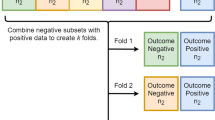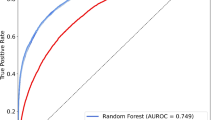Abstract
Cardiac patients undergoing surgery face increased risk of postoperative complications, due to a combination of factors, including higher risk surgery, their age at time of surgery and the presence of co-morbid conditions. They will therefore require high levels of care and clinical resources throughout their perioperative journey (i.e. before, during and after surgery). Although surgical mortality rates in the UK have remained low, postoperative complications on the other hand are common and can have a significant impact on patients’ quality of life, increase hospital length of stay and healthcare costs. In this study we used and compared several machine learning methods – random forest, AdaBoost, gradient boosting model and stacking – to predict severe postoperative complications after cardiac surgery based on preoperative variables obtained from a surgical database of a large acute care hospital in Scotland. Our results show that AdaBoost has the best overall performance (AUC = 0.731), and also outperforms EuroSCORE and EuroSCORE II in other studies predicting postoperative complications. Random forest (Sensitivity = 0.852, negative predictive value = 0.923), however, and gradient boosting model (Sensitivity = 0.875 and negative predictive value = 0.920) have the best performance at predicting severe postoperative complications based on sensitivity and negative predictive value.
Access this chapter
Tax calculation will be finalised at checkout
Purchases are for personal use only
Similar content being viewed by others
Notes
- 1.
- 2.
Attributes are: Age, sex, diabetes, body mass index, smoking status, surgical priority, critical preoperative state, procedure, left main stem, extracardiac arteriopathy, pulmonary disease, creatinine level, renal impairment, New York Heart Association grade, angina status, rhythm, left ventricular function, neurological dysfunction, congestive cardiac failure, previous myocardial infarction, active endocarditis, hypertension, previous cardiac surgery, previous percutaneous coronary intervention.
- 3.
Severe complications in this study include: Acute renal failure, deep sternal wound infection, septicemia, transient stroke, tracheostomy, cardiac arrest, permanent stroke, severe heart failure, adult respiratory distress syndrome, multi-organ failure, mesenteric infarction, required laparotomy, severe pulmonary edema, left ventricular wall dissection, hepatic failure, reopening requiring coronary artery bypass graft, paraparesis, and amputation.
- 4.
References
Findlay, G.P., Goodwin, A.P.L., Protopapa, K., Smith, N.C.E., Mason, M.: Knowing the risk: a review of the peri-operative care of surgical patients, London (2011)
Bouamrane, M.-M., Mair, F.S.: Implementation of an integrated preoperative care pathway and regional electronic clinical portal for preoperative assessment. BMC Med. Inform. Decis. Mak. 14, 93 (2014)
Bouamrane, M.-M., Mair, F.S.: A study of clinical and information management processes in the surgical pre-assessment clinic. BMC Med. Inform. Decis. Mak. 14, 22 (2014)
Moonesinghe, S.R., Mythen, M.G., Das, P., Rowan, K.M., Grocott, M.P.: Risk stratification tools for predicting morbidity and mortality in adult patients undergoing major surgery: qualitative systematic review. Anesthesiology 119, 959–981 (2013)
SCTS: Blue Book Online. http://bluebook.scts.org/
Pinto, A., Faiz, O., Davis, R., Almoudaris, A., Vincent, C.: Surgical complications and their impact on patients’ psychosocial well-being: a systematic review and meta-analysis. BMJ Open 6, e007224 (2016)
Knapik, P., Ciesla, D., Borowik, D., Czempik, P., Knapik, T.: Prolonged ventilation post cardiac surgery - tips and pitfalls of the prediction game. J. Cardiothorac. Surg. 6, 158 (2011)
Eappen, S., et al.: Relationship between occurrence of surgical complications and hospital finances. JAMA 309, 1599–1606 (2013)
Roques, F., Michel, P., Goldstone, A.R., Nashef, S.A.M.: The logistic EuroSCORE. Eur. Heart J. 24, 1–2 (2003)
Nashef, S.A., et al.: EuroSCORE II. Eur. J. Cardio-Thorac. Surg. 41, 734–744 (2012)
Barnett, S., Moonesinghe, S.R.: Clinical risk scores to guide perioperative management. Postgrad. Med. J. 87, 535–541 (2011)
Chawla, N.V., Bowyer, K.W., Hall, L.O., Kegelmeyer, W.P.: SMOTE: synthetic minority oversampling technique. J. Artif. Intell. Res. 16, 321–357 (2002)
Galar, M., Fernandez, A., Barrenechea, E., Bustince, H., Herrera, F.: Review on Ensembles for the Class Imbalance Problem: Bagging-, Boosting-, and Hybrid-Based Approaches. IEEE Trans. Syst. Man Cybern. Part C Appl. Rev. 42, 463–484 (2012)
Kuncheva, L.I.: Combining Patterns Classifiers: Methods and Algorithms. Wiley, New York (2004)
Bischl, B., Mersmann, O., Trautmann, H., Weihs, C.: Resampling methods for meta-model validation with recommendations for evolutionary computation. Evol. Comput. 20, 249–275 (2012)
Freund, Y., Schapire, R.E.: Experiments with a new boosting algorithm. In: The Thirteenth International Conference on Machine Learning, pp. 148–156 (1996)
Friedman, J.H.: Greedy function approximation: a gradient boosting machine. Ann. Stat. 29, 1189–1232 (2001)
Walker, S.H., Duncan, D.B.: Estimation of the probability of an event as a function of several independent variables. Biometrika 54, 167–179 (1967)
Ho, T.K.: The random subspace method for constructing decision forests. IEEE Trans. Pattern Anal. Mach. Intell. 20, 832–844 (1998)
Zhang, H.: The optimality of naive Bayes. In: FLAIRS2004 Conference (2004)
Breiman, L.: Bagging predictors. Mach. Learn. 24, 123–140 (1996)
Valverde-Albacete, F.J., Pelaez-Moreno, C.: 100% classification accuracy considered harmful: the normalized information transfer factor explains the accuracy paradox. PLoS ONE 9, e84217 (2014)
Wang, T.K., Li, A.Y., Ramanathan, T., Stewart, R.A., Gamble, G., White, H.D.: Comparison of four risk scores for contemporary isolated coronary artery bypass grafting. Hear. Lung Circ. 23, 469–474 (2014)
Reis, C., Barbiero, S.M., Ribas, L.: The effect of the body mass index on postoperative complications of coronary artery bypass grafting in elderly. Braz. J. Cardiovasc. Surg. 23, 524–529 (2008)
Kaul, P., Naylor, C.D., Armstrong, P.W., Mark, D.B., Theroux, P., Dagenais, G.R.: Assessment of activity status and survival according to the Canadian Cardiovascular Society angina classification. Can. J. Cardiol. 25, e225–e231 (2009)
Ji, Q., Zhao, H., Mei, Y., Shi, Y., Ma, R., Ding, W.: Impact of smoking on early clinical outcomes in patients undergoing coronary artery bypass grafting surgery. J. Cardiothorac. Surg. 10, 16 (2015)
Sharif-Kashani, B., et al.: Smoking and wound complications after coronary artery bypass grafting. J. Surg. Res. 200, 743–748 (2016)
Geissler, H.J., et al.: Risk stratification in heart surgery: comparison of six score systems. Eur. J. Cardio-Thorac. Surg. 17, 400–406 (2000)
Hirose, H., et al.: EuroSCORE predicts postoperative mortality, certain morbidities, and recovery time. Interact. Cardiovasc. Thorac. Surg. 9, 613–617 (2009)
Pitkänen, O., Niskanen, M., Rehnberg, S., Hippelainen, M., Hynynen, M.: Intra-institutional prediction of outcome after cardiac surgery: comparison between a locally derived model and the EuroSCORE. Eur. J. Cardiothorac. Surg. 18, 703–710 (2000)
Wang, T.K.M., Harmos, S., Gamble, G.D., Ramanathan, T., Ruygrok, P.N.: Performance of contemporary surgical risk scores for mitral valve surgery. J. Card. Surg. 32, 172–176 (2017)
Lutkenhoner, B., Basel, T.: Predictive modeling for diagnostic tests with high specificity, but low sensitivity: a study of the glycerol test in patients with suspected meniere’s disease. PLoS ONE 8, e79315 (2013)
McEvoy, J.W., et al.: Risk and the physics of clinical prediction. Am. J. Cardiol. 113, 1429–1435 (2014)
Author information
Authors and Affiliations
Corresponding author
Editor information
Editors and Affiliations
Rights and permissions
Copyright information
© 2019 Springer Nature Switzerland AG
About this paper
Cite this paper
Lapp, L., Bouamrane, MM., Kavanagh, K., Roper, M., Young, D., Schraag, S. (2019). Evaluation of Random Forest and Ensemble Methods at Predicting Complications Following Cardiac Surgery. In: Riaño, D., Wilk, S., ten Teije, A. (eds) Artificial Intelligence in Medicine. AIME 2019. Lecture Notes in Computer Science(), vol 11526. Springer, Cham. https://doi.org/10.1007/978-3-030-21642-9_48
Download citation
DOI: https://doi.org/10.1007/978-3-030-21642-9_48
Published:
Publisher Name: Springer, Cham
Print ISBN: 978-3-030-21641-2
Online ISBN: 978-3-030-21642-9
eBook Packages: Computer ScienceComputer Science (R0)




